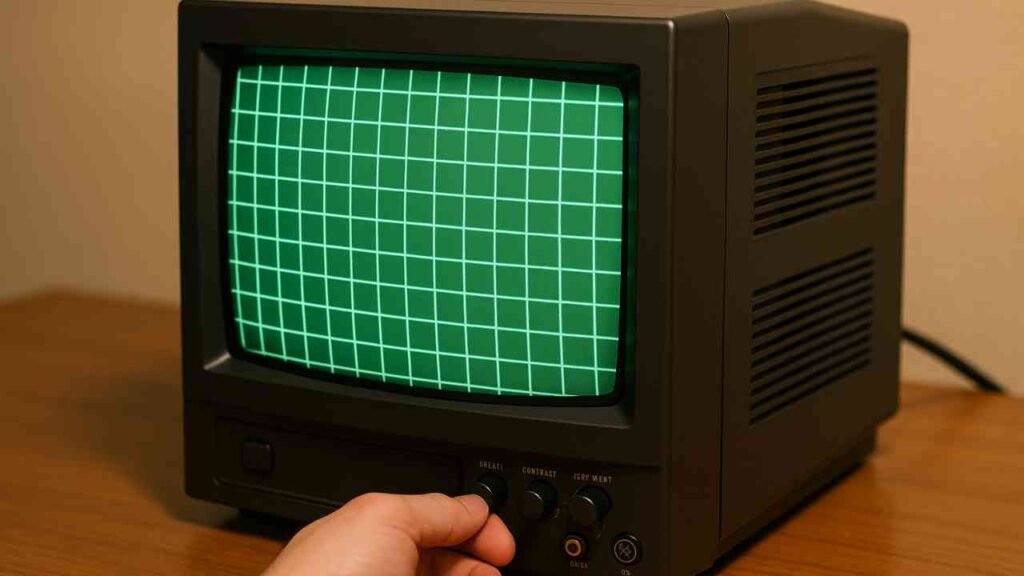Introduction
CRTs (Cathode-Ray Tube TVs) show classic consoles the way they were designed to be seen: razor-clean 240p lines, natural motion, and basically zero display-added input lag. If you’re building a retro setup in 2025, this guide explains which CRT types to look for, which inputs matter, how to test a set before you buy, and the key terms like scanlines, geometry, and convergence—without any piracy talk or risky mods.
CRT Types for Retro Gaming

- Consumer SD TVs (Composite / S-Video / Component): Easiest to find and perfect for consoles from NES to PS2/GameCube/Wii. S-Video and Component are big picture upgrades over Composite.
- RGB/SCART CRT TVs (region dependent): Offer very sharp images with true RGB input. Great if available in your region.
- PC CRT Monitors (VGA): Ideal for DOS/Windows 98 gaming at high refresh rates; need a PC or adapters, not great for consoles without proper signal conversion.
- Pro/Broadcast Monitors (PVM/BVM): Superb color and geometry controls with RGB inputs; harder to source and often pricier.
Flat vs. Curved Screens
- Curved (older) tubes: Classic look, often forgiving geometry; great with 240p.
- Flat (later) tubes: Sharper perceived image and less glare, but some sets show more geometry quirks at the corners.
Pick what looks best to you—performance depends more on the individual set’s condition than the glass shape.
Screen Sizes & Sweet Spots
- 14–20 inch: Super crisp scanlines, great for desk setups and light-gun games.
- 24–27 inch: Nice living-room size; good balance of clarity and immersion.
- 29–32 inch: Big and cinematic, but heavier and more prone to minor geometry issues. Ensure your stand can carry the weight safely.
Inputs & Cables That Matter
- Composite (yellow RCA): Most common, softest image; fine for very early consoles.
- S-Video: Major jump in clarity for N64, PS1, Saturn, etc.
- Component (YPbPr): Excellent for PS2, Xbox, GameCube, Wii (model/region dependent).
- RGB/SCART: Crispest 240p/480i when supported; region-specific availability.
- 15 kHz vs. 31 kHz: Most console CRT TVs are 15 kHz (240p/480i). PC CRTs are 31 kHz+ (480p and up). Know what your source outputs.
Picture Quality Essentials (What You’ll See)
- Geometry: Straight lines should look straight; check corners and edges.
- Convergence: Colors should overlay cleanly (no red/blue “shadows” on white text).
- Focus & Brightness: Text should be legible; highlights shouldn’t bloom.
- Uniformity: No obvious dark patches, rainbowing, or discoloration in corners.
What to Test Before You Buy (Checklist)
- Bring a known console or test pattern and check:
- All inputs (Composite/S-Video/Component/RGB if present).
- Stability (no rolling, flicker, or random shutdowns).
- OSD & remote (menus work, remote included if required).
- Audio (no buzzing/hum independent of volume).
- Physical condition (screen scratches, case cracks, loose jacks).
- Leave it running for 15–20 minutes to expose heat-related faults.
Setup Tips for Consoles
- Use S-Video where available for 5th-gen (N64/PS1/Saturn); Component for PS2/Xbox/GC/Wii.
- Set the TV to 4:3 aspect for classic content.
- If your console offers 60 Hz modes, enable them for smoother motion (region permitting).
- Avoid excessive sharpness in the TV menu—let the source signal shine.
Using Modern HDMI Devices on a CRT
- If you must feed HDMI into a CRT, use an HDMI-to-analog converter that explicitly supports 240p/480i (many generic boxes don’t and will add lag or force 480p only).
- Prefer downscalers/converters designed for retro signals. Always verify supported resolutions and refresh rates before buying.
Light-Gun Games & Timing
- Original light guns (NES Zapper, GunCon, etc.) require CRT scanning to work correctly. They generally won’t function on LCD/OLED—even with adapters—so a CRT is the authentic solution.
Safety, Care & Moving
- Do not open a CRT. High voltages can remain even when unplugged.
- Clean the glass with a dry microfiber first; if needed, lightly dampen the cloth (never spray directly).
- Ensure ventilation around the set; heat shortens lifespan.
- Lift with two people, from the bottom. Protect the tube face during transport.
Common Myths (Quick Reality Check)
- “HD CRTs are always better.” Not for 240p; many HD sets upscale internally, sometimes adding softness or processing.
- “Bigger is always better.” Larger tubes can struggle with geometry; image quality depends on the individual unit.
- “Any HDMI converter works.” Many don’t support 240p properly and can add lag—check specs.
Quick Picks Cheat Sheet (By Use-Case)
- Arcade/Pixel-Art Purist: 20–27″ consumer CRT with S-Video/Component, or RGB/SCART if available.
- Light-Gun Fan: Small-to-medium consumer CRT with minimal processing and bright, even screen.
- Retro PC Enthusiast: VGA/SVGA PC CRT monitor for high refresh DOS/Win98 titles.
- Showpiece Setup: Clean, late-model consumer CRT with Component (and RGB/SCART where regional).
Legal & Ethical Note
Enjoy your hardware with original media, official re-releases, licensed collections, FPGA/official hardware, and homebrew with permission. No ROM piracy.
Conclusion
A good CRT TV brings back the look, motion, and responsiveness classic games were built around: crisp 240p with natural scanlines and essentially zero display-added delay. Choose the right inputs, test carefully, and handle safely—and your retro setup will feel authentic, responsive, and gorgeous for years.
